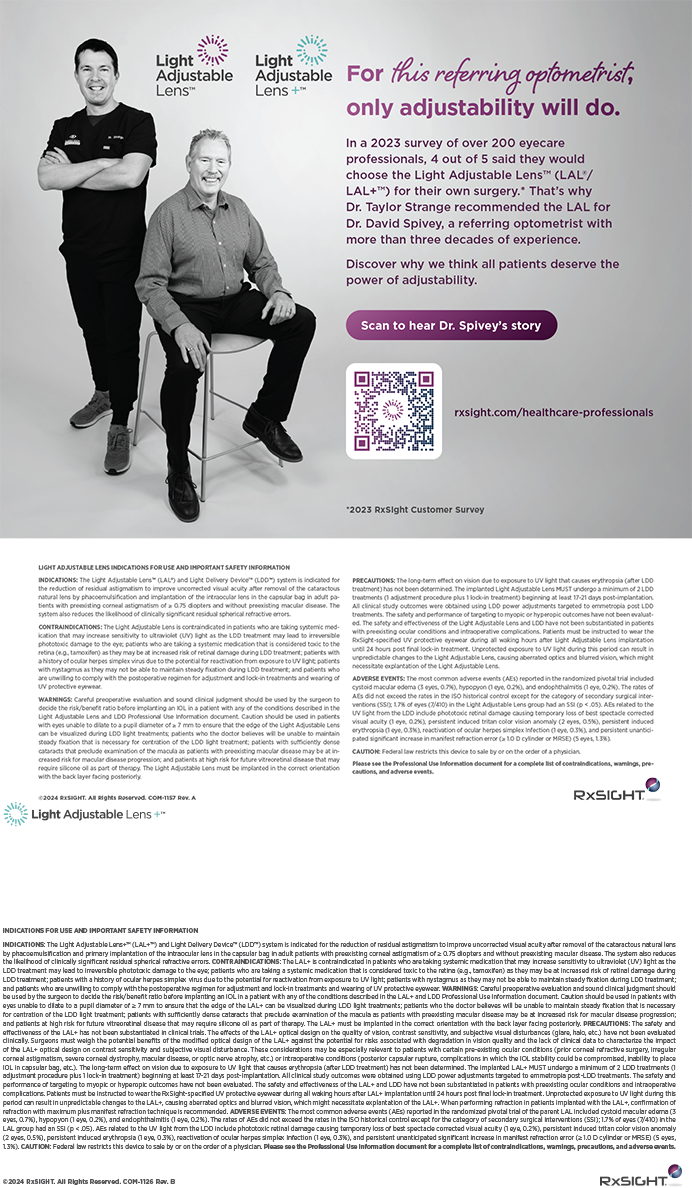In choosing an IOL, I look for predictability, reliability, and ease of use. I always tell the surgeons I am training that instruments and lenses are like an extension of your hands: you need to know exactly what they are going to do in the eye and, with IOLs, how they are going to perform long term. Most modern single-piece IOLs deliver this kind of confidence. The new enVista IOL (Bausch + Lomb) has several features that improve handling, facilitate its proper placement, and support excellent long-term visual outcomes.
THE NEXT GENERATION OF ACRYLIC LENS
The enVista is a single-piece, ultraviolet light-absorbing, hydrophobic acrylic IOL. It is made from an advanced material [hydroxyethyl methacrylate (HEMA)-polyethylene glycol phenyl ether acrylate (poly[EG] PEA)-styrene copolymer, cross-linked with ethylene glycol dimethacrylate] that renders the surface resistant to scratches or abrasions. Most importantly, the IOL is packaged to prevent the formation of glistenings to ensure excellent clarity before and after surgery. The enVista lens is the only hydrophobic acrylic IOL to have labeling stating that no glistenings of any grade were reported for any subject at any visit in the clinical study.1 The lens features an aberration-free, aspheric optic (neutral asphericity) to deliver enhanced contrast sensitivity without compromising the depth of field. In addition, the IOL's optic is less sensitive than aspheric lenses with negative spherical aberration to visual disturbances due to tilt or decentration, essentially providing a larger “sweet spot.” It is also designed to minimize posterior capsular opacification with a sharp 360º square posterior edge as well as step-vaulted haptics for direct contact with the capsular bag. The enVista is available in the widest dioptric range of hydrophobic lenses (0 to +34.00 D), and it is readily inserted through a 2.2-mm wound assist or a 2.6-mm conventional incision.
THE PROBLEM OF GLISTENINGS
Glistenings are fluid-filled microvacuoles that may form in acrylic lens material. They are a wellcharacterized phenomenon, particularly in hydrophobic lenses. Glistening rates for hydrophobic acrylic IOLs range from 30% to 60% in published studies.2-5
Prior to a lens' implantation, glistenings can result from material composition or nonuniformity, the manufacturing process, changes in equilibrium water content caused by temperature fluctuations, or sterilization techniques and packaging.6-8 Glistenings can also form once the lens is in the eye due to postimplantation temperature changes in the anterior chamber, water vacuoles that form after lens hydration in the eye, glaucoma, or other conditions leading to the breakdown of the blood-aqueous barrier.3,5,7,9
Although surgeons usually consider glistenings to be a cosmetic problem, many of my patients have had mild (and a few moderate) dysphotopsia related to vacuoles that have formed in their hydrophobic lenses. The worst case I have seen is that of a patient with a diffractive IOL who had a visual acuity of 20/20 for about 3 years after surgery. When I examined her recently, however, she had macro- and microvacuoles in the lenses in both eyes, which had decreased her visual acuity to 20/70 OD and 20/50 OS. I now have to consider explanting and replacing both lenses, which is no easy task after 3 years with an open posterior capsule.
THE IOL IN MY HANDS
I was the first surgeon to implant the enVista in the United States in August 2012, and to date, I have implanted nearly 100 of these lenses (Figures 1-3). I am now using the enVista in most of my primary monofocal cases, with the exception of patients who have had prior hyperopic laser vision correction in whom I use a nonaspheric lens. I have continued to be impressed with the exceptional optical clarity of the lens material and have come to appreciate its scratch-resistant qualities as well. Another advantage of the lens is its controlled unfolding, which gives me ample time for manipulation so I can place it exactly where I want. This feature also allows me to get behind the lens much more easily with my I/A tip to remove viscoelastic.
CONCLUSION
Surgeons are fortunate to have a wide selection of excellent IOLs, allowing them to choose the lenses that perform best in their hands and to offer an excellent visual outcome to each individual cataract patient. The enVista is a welcome addition to the IOL armamentarium, particularly because of its scratch-resistant, glistening-free acrylic material and controlled handling. I know how this lens is going to perform in my hands today and, more importantly, in the patient's eye tomorrow.
A. James Khodabakhsh, MD, is clinical assistant professor of ophthalmology at New York Medical College and has a private practice in Beverly Hills, California. He is a consultant to Abbott Medical Optics Inc., Alcon Laboratories, Inc., and Bausch + Lomb. Dr. Khodabakhsh may be reached at lasereyedoc@aol.com.
- Bausch + Lomb Study #658. Final clinical study report: a prospective multicenter clinical study to evaluate the safety and effectiveness of a Bausch + Lomb one-piece hydrophobic acrylic intraocular lens in subjects undergoing cataract extraction. Published August 24, 2011.
- Trattler W. Glistenings visually relevant. EyeWorld. Published 2007. http://www.eyeworld.org/ewsupplementarticle. php?id=261. Accessed April 4, 2013.
- Moreno-Montañés J, Alvarez A, Rodríguez-Conde R, Fernández-Hortelano A. Clinical factors related to the frequency and intensity of glistenings in AcrySof intraocular lenses. J Cataract Refract Surg. 2003;29(10):1980-1984.
- Colin J, Orignac I, Touboul D. Glistenings in a large series of hydrophobic acrylic intraocular lenses. J Cataract Refract Surg. 2009;35(12):2121-2126.
- Wittpenn JR. Prevalence of glistenings in AcrySof intraocular lenses. Poster presented at: ARVO 2010; May 6, 2010; Fort Lauderdale, FL.
- Shiba T, Mitooka K, Tsuneoka H. In vitro analysis of AcrySof intraocular lens glistening. Eur J Ophthalmol. 2003;13(9-10):759-763.
- Miyata A, Yaguchi S. Equilibrium water content and glistenings in acrylic intraocular lenses. J Cataract Refract Surg. 2004;30(8):1768-1772.
- Werner L. Glistenings and surface light scattering in intraocular lenses. J Cataract Refract Surg. 2010;36(8):1398-1420.
- Dhaliwal DK, Mamalis N, Olson RJ, et al. Visual significance of glistenings seen in the AcrySof intraocular lens. J Cataract Refract Surg. 1996;22(4):452-457.


